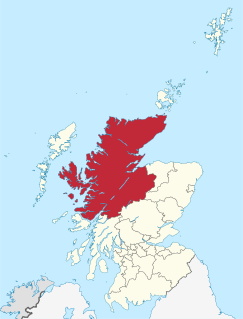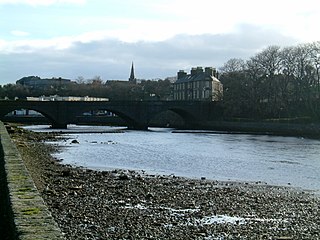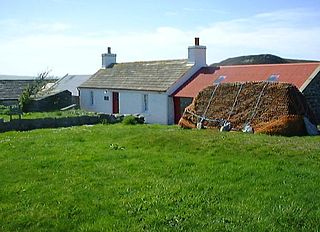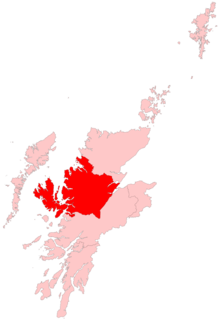
Highland is a council area in the Scottish Highlands and is the largest local government area in the United Kingdom. It was the 7th most populous council area in Scotland at the 2011 census. It shares borders with the council areas of Aberdeenshire, Argyll and Bute, Moray and Perth and Kinross. Their councils, and those of Angus and Stirling, also have areas of the Scottish Highlands within their administrative boundaries.

Thurso is a town and former burgh on the north coast of the Highland council area of Scotland. Situated in the historical area of Caithness, it is the northernmost town on the British mainland.

Caithness is a historic county, registration county and lieutenancy area of Scotland.

Wick is a town and royal burgh in Caithness, in the far north of Scotland. The town straddles the River Wick and extends along both sides of Wick Bay. "Wick Locality" had a population of 6,954 at the time of the 2011 census, a decrease of 3.8% from 2001.

Lairg is a village and parish in Sutherland, Scotland. It has a population of 891 and is at the south-eastern end of Loch Shin.

Olrig is a parish in Caithness, Scotland. The main settlement in the parish is Castletown. Prior to the 19th century, the parish was sub-divided into ten townlands or "fermlands". Townland boundaries were mostly disregarded and lost during the agricultural improvements in the 19th century, but many townland names remain identifiable with farmstead names ending with Mains.

Caithness, Sutherland and Easter Ross is a constituency of the House of Commons of the Parliament of the United Kingdom (Westminster). It is the most northerly constituency on the British mainland. It elects one Member of Parliament (MP) by the first-past-the-post system of election.

Dunnet is a village in Caithness, in the Highland area of Scotland. It is within the Parish of Dunnet.

The A836 is a major road entirely within the Highland area of Scotland. It is 122 miles (196 km) long and runs from Ross and Cromarty to Caithness, with the majority of its length in Sutherland. At 58.648°N where it passes through East Mey, it is the northernmost A-class road in mainland Great Britain.

The A99 road is entirely within the former county of Caithness in the Highland of Scotland. It runs generally north/northeast from the A9 at Latheron to Wick and to the A836 at John o' Groats. It was part of the A9 until the A9 classification was transferred to what had been the A895-A882 link between Latheron and Thurso. Between Latheron and Wick it follows, mostly, the route of one of Telford's roads.

Ross, Skye and Inverness West was a constituency of the Scottish Parliament (Holyrood). It elected one Member of the Scottish Parliament (MSP) by the first past the post method of election. Also, however, it is one of eight constituencies in the Highlands and Islands electoral region, which elects seven additional members, in addition to eight constituency MSPs, to produce a form of proportional representation for the region as a whole.

Reay is a village which has grown around Sandside Bay on the north coast of the Highland council area of Scotland. It is within the historic Parish of Reay and the historic county of Caithness.

Watten is a small village in Caithness, in the Highland area of Scotland, on the main road (A882-A9) between the burgh of Wick and the town of Thurso, about twelve kilometres west of Wick and close to Wick River and to Loch Watten. The village is on The Far North railway line but trains stopped calling at the village in 1960. The railway station is now a private house.
Ardgay /ɑːrdˈɡaɪ/ ["high wind" - see below Further reading: MacGregor] is a small Scottish village on the south west shore of the Dornoch Firth, Sutherland and is 1 mile south from Bonar Bridge and lies at the entrance to Strathcarron, the valley of the River Carron and is at the mouth of the Kyle of Sutherland.
The Sutherland and Caithness Railway was a Scottish railway company that built a line from Helmsdale, the terminus of the Duke of Sutherland's Railway to Wick and Thurso in Caithness, giving the northern towns access to Inverness. It was driven through by the efforts of the 3rd Duke of Sutherland and the engineer Joseph Mitchell in the face of apathy from interests in Wick.

Caithness, Sutherland and Ross is a constituency of the Scottish Parliament covering the northern part of the Highland council area. It elects one Member of the Scottish Parliament (MSP) by the first past the post method of election. It is also one of eight constituencies in the Highlands and Islands electoral region, which elects seven additional members, in addition to eight constituency MSPs, to produce a form of proportional representation for the region as a whole.

Gail Elizabeth Ross is a former Scottish National Party (SNP) politician, who served as the Member of the Scottish Parliament (MSP) for Caithness, Sutherland and Ross from the election in May 2016 Up until 2021 when she decided to not seek re-election. She was a councillor on the Highland Council 2011–2016, and civic leader of Caithness 2012–2016.

The 1st Caithness Artillery Volunteers were formed in 1860 as a response to a French invasion threat. They served as a Coast Artillery unit and continued in existence as part of the Royal Garrison Artillery until being disbanded on the formation of the Territorial Force in 1908.
The North Highland Way is a 150 miles (240 km) hiking, cycling and horse riding trail in Scotland. It starts from Duncansby Head on the North East coast to Cape Wrath in the North West of Scotland's coast. The North Highland Way connects the Cape Wrath Trail in the west with the Moray Firth trail in the east. The North Coast 500 is a driving route, which follows a similar line to the North Highland Way.


















